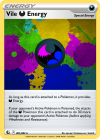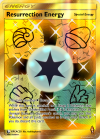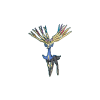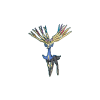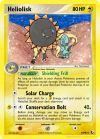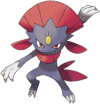References:
Erika's Charity ("If [that Pokémon] attacks...")
Dark Machoke ("Before doing damage...)
A tentative reference to Agility ("... that attack's effects, including damage...")
Metal Energy ("If the Pokémon... attacks the Defending Pokémon.")
Misty's Staryu/Brock's Sandslash ("isn't affected... effects on the Defending Pokémon)
Erika's Charity ("If [that Pokémon] attacks...")
Dark Machoke ("Before doing damage...)
A tentative reference to Agility ("... that attack's effects, including damage...")
Metal Energy ("If the Pokémon... attacks the Defending Pokémon.")
Misty's Staryu/Brock's Sandslash ("isn't affected... effects on the Defending Pokémon)
This card is meant to release in Team Rocket, along with Rainbow Energy, Potion Energy, and Full Heal Energy. However, for the sake of discussion you could assume it was reprinted with the latter two in Legendary Collection, which would make it fair game for the entire Wizards of the Coast era, with the exceptions of Base, Base-Jungle, Base-Fossil, and e-card block. That's a fairly large range, but anything outside that is no-go thanks to the wording "Pokémon Powers." You could argue that the card was reprinted with errata, but I leave it up to you to determine if precedent for any sort errata outside of a full rename exists.
(I put this here to set it apart from the giant wall of text that follows.)
(I put this here to set it apart from the giant wall of text that follows.)
Let's face it. The original Double Colorless Energy doesn't have the words "Special Energy" printed on it. It was not declared to *be* a Special Energy until Pokémon had the idea of creating *more* energy that "doesn't count as a basic Energy card." So while Double Colorless Energy was technically affected by Light Golduck, Light Dragonite, and Smoochum going forward, we can't honestly say Base Set was the set that created Special Energy. That title goes to Team Rocket.
The Special Energy in Team Rocket can be divided into two thematic categories: I like to call these categories "element" and "effect." The "element" Special Energy card, Rainbow Energy, is thematically tied to Double Colorless Energy by a play on color and the balancing of increased Energy cost fulfillment utility with a downside. Double Colorless's downside is... well, it's not colored Energy, and that's about it. Hence the complaint that DCE breaks... everything it touches. (*Laughs in Garchomp C Lv.X.*) Rainbow Energy's downside is that it places a damage counter, which, in that era, was nothing to sneeze at, though it was a worthwhile tradeoff in deck's like Base-Rocket's Dodrio Potpouri or Venusaur in Base-Rocket and later.
The other class of Special Energy is "effect." These Special Energy were based off of healing items from the games (both of which also had TCG representations) and had an effect that healed your Pokémon by removing a damage counter (Potion Energy) or removing a Special Energy (Full Heal Energy).
Having divided the Special Energy era into these two categories, I at first decided to create an "effect" class Energy. And to a certain extent, I have, but I deviated from the "healing item" mold I had created for this category for a few reasons. First, I quickly realized this would essentially limit me to one-line effects like "when you attach this card from your hand to one of your Pokémon, remove all effects from that Pokémon" (this was actually my first draft for a submission, which I planned on calling "Ether Energy," in honor of the medicinal item of that name). I know Pokémon Ranger was a great card, but it felt weird extending the card to only affect the Active, and while another person could certainly design around it, it's most practical application in standard would be to break through Magmar's Smoke Screen, for which purpose it probably wouldn't be worth the space as a one-time effect.
All this time I had a nagging itch in the back of my mind. A day or two into brainstorming, I realized I wanted, if possible, to create a counter to Mr. Mime from Jungle, one of my least favorite cards to play against. In fact, players from as far back as Jungle have shared similar sentiments on this card. Then inspiration hit me: rather than focus on a medicinal item, I decided to focus on a key item: Silph Scope. After all, what better way could there be to unmask Mr. Mime than by unmasking its invisible wall?
I chose to design this effect with Swift as the base line of text. At first I removed the "Weakness" and "Resistance" from the effect to make it more focused. Getting through cards like Mr. Mime JU and Haunter FO is a good effect to have, especially in Prop 15/3, where Mr. Mime may be one of the most degenerate cards in the card pool (especially when paired with Alakazam, Chansey, Pokémon Center, and, as an upgrade from its Base-Jungle debut, Sabrina's Golduck). This limits a few archetypes from Prop 15/3, including the aforementioned stall deck and a Brock's Mankey trapper/Brock's Golbat spread deck, the latter of which runs both Mr. Mime and Haunter. This, I realized, was still a little niche, so I decided to add the resistance clause back in to reference foresight and odor sleuth--alternative means of unmasking ghost type Pokémon, as well the general act of moving barriers (resistance walls a lot of attacks in this format). This, I reasoned, would help the card see more play outside of Prop 15/3, such as by enabling Grass types to actually do more than lightly graze Steel types. At that point I realized I would be unleashing a monster if I didn't restore the word "Weakness" to the base formula, since the card would essentially negate the skill of playing around resistance when building around Pokémon that have any Colorless Energy in their attack costs. It doesn't rule out the option of retreating to bump the Silph Scope Energy, but that option is probably harmless enough, and restores a healthy dose of sequencing to the format.
I meticulously pruned the wording so that this Energy allows you to get past Haunter FO's Transparency as well as Mr. Mime JU's Invisible Wall. (Note that Suicune N2 Holo is also included on this list, which is probably more relevant in Japan's Hall of Fame format than in any international format, since I've seen Japanese Rain Dance lists that run Suicune N2 Holo, but can only find the non-Holo one listed on ptcgarchive and see no Suicune N2 whatsoever listed on Jason Klaczynski's blog.)
Here is my reference for the effect that lets the Pokémon's attacks go through Invisible Wall:
Swift: This attack’s damage isn’t affected by Weakness, Resistance, Pokémon Powers, or any other effects on the Defending Pokémon.
And here's an important ruling on why this works:
Q. If I use Misty's Staryu's Swift attack or Neo: Genesis' Electabuzz's Swift attack and I attach PlusPowers, will it go through Invisible Wall?
A. The Swift attack ignores Invisible Wall regardless of the PlusPower being added on. (Aug 31, 2000 WotC Chat, Q85; Dec 21, 2000 WotC Chat, Q111 & Q112)
The Special Energy in Team Rocket can be divided into two thematic categories: I like to call these categories "element" and "effect." The "element" Special Energy card, Rainbow Energy, is thematically tied to Double Colorless Energy by a play on color and the balancing of increased Energy cost fulfillment utility with a downside. Double Colorless's downside is... well, it's not colored Energy, and that's about it. Hence the complaint that DCE breaks... everything it touches. (*Laughs in Garchomp C Lv.X.*) Rainbow Energy's downside is that it places a damage counter, which, in that era, was nothing to sneeze at, though it was a worthwhile tradeoff in deck's like Base-Rocket's Dodrio Potpouri or Venusaur in Base-Rocket and later.
The other class of Special Energy is "effect." These Special Energy were based off of healing items from the games (both of which also had TCG representations) and had an effect that healed your Pokémon by removing a damage counter (Potion Energy) or removing a Special Energy (Full Heal Energy).
Having divided the Special Energy era into these two categories, I at first decided to create an "effect" class Energy. And to a certain extent, I have, but I deviated from the "healing item" mold I had created for this category for a few reasons. First, I quickly realized this would essentially limit me to one-line effects like "when you attach this card from your hand to one of your Pokémon, remove all effects from that Pokémon" (this was actually my first draft for a submission, which I planned on calling "Ether Energy," in honor of the medicinal item of that name). I know Pokémon Ranger was a great card, but it felt weird extending the card to only affect the Active, and while another person could certainly design around it, it's most practical application in standard would be to break through Magmar's Smoke Screen, for which purpose it probably wouldn't be worth the space as a one-time effect.
All this time I had a nagging itch in the back of my mind. A day or two into brainstorming, I realized I wanted, if possible, to create a counter to Mr. Mime from Jungle, one of my least favorite cards to play against. In fact, players from as far back as Jungle have shared similar sentiments on this card. Then inspiration hit me: rather than focus on a medicinal item, I decided to focus on a key item: Silph Scope. After all, what better way could there be to unmask Mr. Mime than by unmasking its invisible wall?
I chose to design this effect with Swift as the base line of text. At first I removed the "Weakness" and "Resistance" from the effect to make it more focused. Getting through cards like Mr. Mime JU and Haunter FO is a good effect to have, especially in Prop 15/3, where Mr. Mime may be one of the most degenerate cards in the card pool (especially when paired with Alakazam, Chansey, Pokémon Center, and, as an upgrade from its Base-Jungle debut, Sabrina's Golduck). This limits a few archetypes from Prop 15/3, including the aforementioned stall deck and a Brock's Mankey trapper/Brock's Golbat spread deck, the latter of which runs both Mr. Mime and Haunter. This, I realized, was still a little niche, so I decided to add the resistance clause back in to reference foresight and odor sleuth--alternative means of unmasking ghost type Pokémon, as well the general act of moving barriers (resistance walls a lot of attacks in this format). This, I reasoned, would help the card see more play outside of Prop 15/3, such as by enabling Grass types to actually do more than lightly graze Steel types. At that point I realized I would be unleashing a monster if I didn't restore the word "Weakness" to the base formula, since the card would essentially negate the skill of playing around resistance when building around Pokémon that have any Colorless Energy in their attack costs. It doesn't rule out the option of retreating to bump the Silph Scope Energy, but that option is probably harmless enough, and restores a healthy dose of sequencing to the format.
I meticulously pruned the wording so that this Energy allows you to get past Haunter FO's Transparency as well as Mr. Mime JU's Invisible Wall. (Note that Suicune N2 Holo is also included on this list, which is probably more relevant in Japan's Hall of Fame format than in any international format, since I've seen Japanese Rain Dance lists that run Suicune N2 Holo, but can only find the non-Holo one listed on ptcgarchive and see no Suicune N2 whatsoever listed on Jason Klaczynski's blog.)
Here is my reference for the effect that lets the Pokémon's attacks go through Invisible Wall:
Swift: This attack’s damage isn’t affected by Weakness, Resistance, Pokémon Powers, or any other effects on the Defending Pokémon.
And here's an important ruling on why this works:
Q. If I use Misty's Staryu's Swift attack or Neo: Genesis' Electabuzz's Swift attack and I attach PlusPowers, will it go through Invisible Wall?
A. The Swift attack ignores Invisible Wall regardless of the PlusPower being added on. (Aug 31, 2000 WotC Chat, Q85; Dec 21, 2000 WotC Chat, Q111 & Q112)


